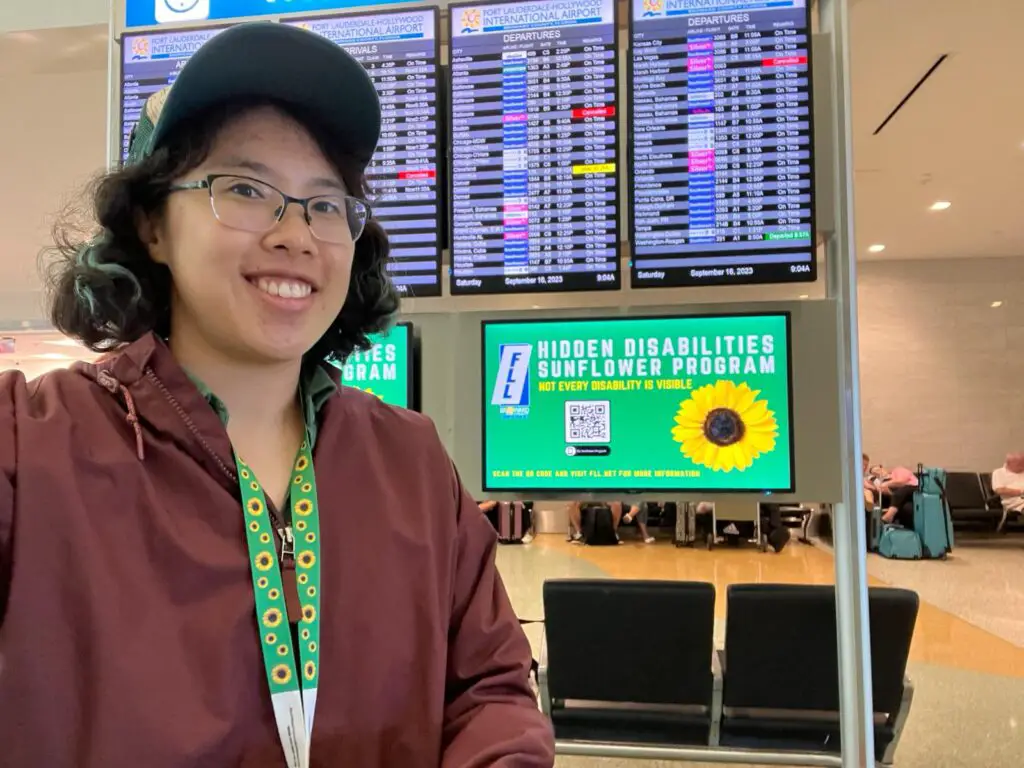
Posted: February 5, 2024
Airport travel can be overwhelming. From catching planes on time to speeding through security lines, it’s a lot to deal with.
For folks with hidden disabilities, it may be extra challenging to travel through airports and fly on planes. That’s why if you have a hidden disability, consider getting a Sunflower Lanyard. It makes airport travel more accessible. At participating airports and on certain airlines, the staff can help you. The lanyard is free, and you can keep it for life!
As a traveler with a hidden disability, I’ve worn the lanyard through North America, Europe, the Middle East, Asia, and Oceania through several airports and airlines. I’ve also met other folks like my autistic traveler friend with the lanyard. I want to share my firsthand experience and hours-long research so that you can travel with it too!
Table of Contents
Why get the lanyard?
If you have a hidden disability, the lanyard can make traveling easier at many airports around the world (especially in its home country, the United Kingdom).
Wear the lanyard at participating airports and airlines so staff can recognize that you have a hidden disability. You don’t need to disclose your disability. They’ll support you however they can. This may mean being patient and giving you more time.
The lanyard is optional. If you have a hidden disability but don’t need help, then don’t wear it. Wear it only if you would like more support or patience from airport employees.
I always wear the lanyard at participating airports and airlines. At UK’s Manchester Airport in 2022, the security staff took me to the front of the security line. At Sydney Airport in 2024, they took me to an empty security line. This way, I didn’t feel rushed to get my bags scanned. It helped me with my OCD fear of losing things!
Some airlines recognize the lanyard too. In 2024, when I boarded my Jetstar flight from Sydney to Ayers Rock, a flight attendant with a genuine smile asked if I needed any help. I didn’t, but it was nice to know that I could be supported at any time.
The Sunflower Lanyard does not expedite customs and border patrol. You may or may not get automatic expedited security lines. It depends on the airport. Manchester and Sydney do, but not Fort Lauderdale and Singapore Changi. If staff aren’t reaching out to you automatically, ask for help.
Who can wear the lanyard?
Anybody with a hidden disability can wear it. A disability is hidden if on the surface, people don’t see that you have a disability. Hidden disabilities can be mental or physical.
I have OCD, a hidden mental disability. If you meet me, you’ll see me as an able-bodied person. Nothing about my appearance suggests OCD.
Mental hidden disabilities include (but aren’t limited to):
- ADHD (attention deficit hyperactivity disorder)
- Autism
- Anxiety
- Depression
- Learning disabilities
- Obsessive compulsive disorder (OCD)
Physical hidden disabilities include (but aren’t limited to):
- Impairments with vision, speech, hearing, or mobility
- A lung condition (like asthma or COPD)
- Chronic pain
- Chronic conditions (like diabetes)

What does the lanyard mean?
Everyone deserves to travel. This lanyard makes travel more accessible by supporting travelers with hidden disabilities.
Having a hidden disability can be frustrating. People may not believe you need help because they can’t see your disability. As they say, “Seeing is believing.” The lanyard is a subtle visual cue for airport staff to know that you have a hidden disability.
The bigger picture is that the lanyard makes folks with hidden disabilities less excluded. This leads people to be more empathetic and accepting of hidden disabilities.
Hidden disabilities are normal. Here are stats from the official Hidden Disabilities program:

Why sunflowers? They are cheerful, gender-neutral flowers that represent fortitude and confidence. Crucial stuff for a life with a disability! The sunflower is practical, too. From afar, people can spot bright yellow flowers.
To learn more about the Sunflower Lanyard’s worldwide use, read my complete guide on its meaning.
Is the lanyard free?
If you pick it up at a participating airport or other location, yes, it’s free! You can keep it forever.
Where can I get a lanyard?
Once you have travel plans departing or arriving at an airport that recognizes the Sunflower Lanyard, then you can pick one up at that airport.
If you see a Sunflower poster or sign at any other institution, you may also get a free Sunflower Lanyard there. Just ask! At Melbourne’s Australian Sports Museum, I saw a Sunflower poster and staff wearing a Sunflower badge. The staff told me that I could pick up a lanyard from them. Here are all the participating institutions around the world.
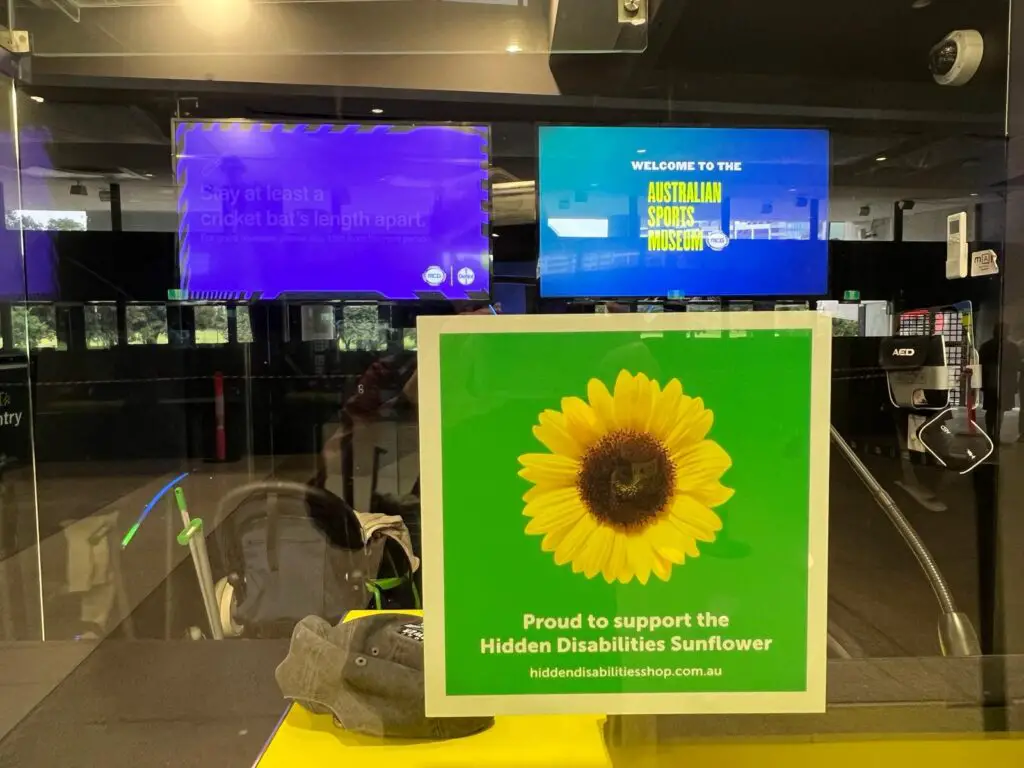
If you want it shipped to your house before you travel, buy it for a small price at the official Hidden Disabilities store.
How do I get a lanyard at an airport?
Follow these easy steps:
- Arrive or depart from any participating airport.
- Ask the staff where you can pick up a lanyard. They’ll direct you to the office that gives out the lanyards.
- Have your flight itinerary on your phone or on paper ready to show the staff. They may ask you for it. Then, they’ll give you your lanyard.
The staff won’t ask you to prove your disability. There are no questions asked, no sign-up forms.
Getting the lanyard took me only a minute. At UK’s Manchester Airport in 2022, I was quickly directed to the office on the departure level. They asked me for my flight itinerary. I showed it on my phone (Manchester to Berlin on Ryanair). Then, they gave me a lanyard. So easy!
Which airports recognize the lanyard?
The Hidden Disabilities website has a complete list of airports around the world. As of February 2024, over 230 airports recognize the lanyard. The list keeps growing!
The lanyard is recognized in most major regions, including North and Latin America, the Caribbean, Europe, Asia, and Oceania. The widest airport coverage is in the US, UK, Australia, New Zealand, and Canada. Other countries may only have one or a few supporting airports.
Popular travel destinations with Sunflower airports include the United States, Canada, Germany, Ireland, the United Kingdom, Italy, Iceland, Japan, Singapore, Australia, and New Zealand.
Which airlines recognize the lanyard?
As of February 2024, 15 airlines recognize the lanyard: Air France, Air New Zealand, Atlantic Airways, Austrian, British Airways, Corendon Airlines, Emirates, Jetstar, KLM Royal Dutch Airlines, LATAM Airlines, Qantas, Ryanair, TUI fly, Transavia, and Turkish Airlines.
If you fly any of these airlines, wear your Sunflower Lanyard. Their flight crew has been trained to support you. Sure enough, in 2024, a Jetstar flight attendant asked me if I needed support as soon as I boarded my plane from Sydney to Ayers Rock.
Air New Zealand provides a few examples of how their flight crew can help you. They can:
- Give you more time to check in and board the plane
- Help you read departure signs
- Let you stay with friends and family
- Provide expectations of your flight journey
What other institutions recognize the lanyard?
Use this interactive map by the Hidden Disabilities program to find other institutions in your next travel destination.
In some countries like the US and Australia, the lanyard is recognized at other public places besides airports. This includes travel institutions like museums, tourism boards, and train stations.
It’s nice knowing that travelers are supported not just at the airport, but in their everyday travels. During my 3-month stay in Australia, I saw Sunflower posters at museums and train stations, like Melbourne’s iconic Flinders Street Station.
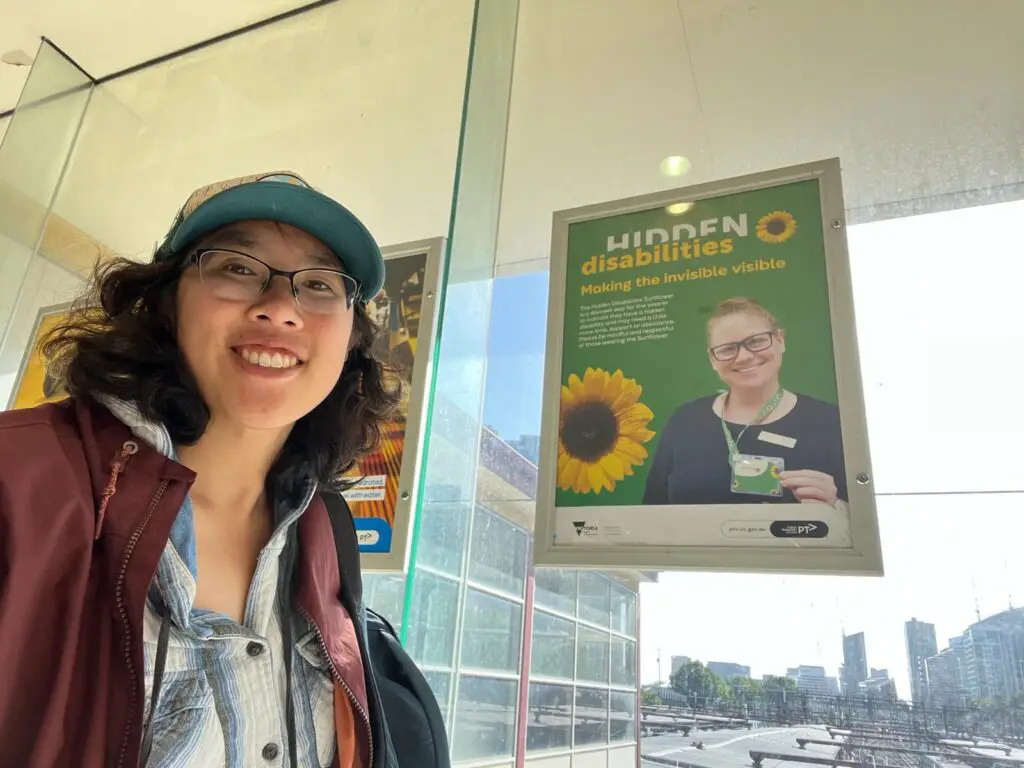
The UK is the land of the sunflower! So far, it’s the only country where I’ve seen others wearing the lanyard in everyday life. I have a British friend with a personalized “autism” card on her lanyard (learn more about the lanyard used with autism here). At a museum in England, I met a volunteer with an “anxiety” card. Many British institutions recognize the lanyard, including hospitals, supermarkets, shopping centers, bus and train stations, and tourist attractions. So do emergency responders in fire, ambulance, and law enforcement.
Learn more about the lanyard’s meaning and worldwide use in my everyday Sunflower guide.
When did the lanyard program start?
London Gatwick Airport launched the program in May 2016. The staff at London Gatwick Airport asked themselves,
How can we identify that one of our passengers may have a non-obvious disability?
They set out to plant the (sunflower) seeds. Not only were people becoming more accepting of hidden disabilities, but other institutions also started recognizing the lanyard. The lanyard practice has since exploded in the UK. Since its inception at Gatwick, it took two years for all major UK airports to launch the program. The UK’s Manchester Airport took it one step further with the “Sunflower Room,” a quiet and peaceful space. This is the airport where I picked up my lanyard.
In 2018, the program helped foreign countries’ airports begin the program by sharing training and planning protocols.
In 2019, along with the online store, the program made its international airport debut in the following cities:
- Australia: Sydney and Brisbane
- United States: Seattle-Tacoma and San Jose
- Europe: Copenhagen, Denmark; Trieste, Italy; and Amsterdam, the Netherlands
- Eurasia: Istanbul, Turkey
- Middle East: Dubai, United Arab Emirates
The traveling world has become a bit more understanding and empathetic, thanks to a green lanyard dotted with sunflowers.
***
I love traveling despite having OCD. Though no one sees it, my OCD is triggered by the idea of losing my passport and phone at the security belt. I’m glad that I can get extra support if need be, thanks to the Hidden Disabilities Sunflower Lanyard.
If you have a hidden disability like me, you can grab a free lanyard at a participating airport. A little help goes a long way! It’s about time that the world’s airports be a bit more accessible for travelers.
Sources
Airports around the world. Hidden Disabilities Sunflower Scheme Limited, n.d., https://hdsunflower.com/us/insights/post/airports-around-the-world. Accessed 18 July 2023.
Hidden Disabilities Sunflower lanyard. Air New Zealand, n.d., https://www.airnewzealand.co.nz/hidden-disabilities-sunflower. Accessed 22 July 2023.
Invisible Disabilities: List and General Information. Disabled World, 1 May 2023, https://www.disabled-world.com/disability/types/invisible/. Accessed 18 July 2023.
What is the Hidden Disabilities Sunflower? Hidden Disabilities Sunflower Scheme Limited, n.d., https://hdsunflower.com/us/insights/post/for-people-with-non-visible-disabilities. Accessed 18 July 2023.
(Image credit: Featured image from Getty Images and the BBC).
(Image credit: Hidden disability infographics and airline list from the Hidden Disabilities Sunflower Scheme).
Pin to save this post for later, and share it with others!
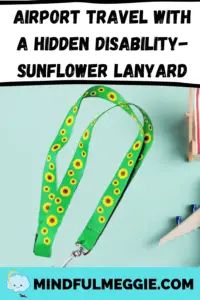





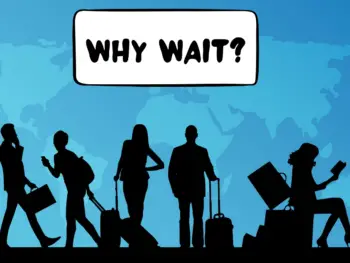

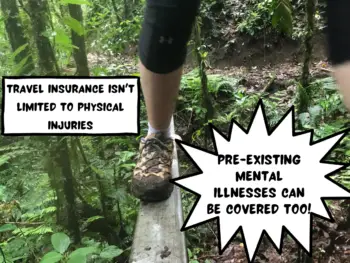

 10 Tips for Traveling with OCD (I Did, So Can You)
10 Tips for Traveling with OCD (I Did, So Can You)
This article is really great! I had no idea that such a lanyard and system exist. I hope that this idea begins to spread to other airports (and beyond airports!). Thank you for sharing this helpful information!
For some reason, the lanyard isn’t well known. I hope my post will change that. Thank you for your lovely comment, Christine!
After year’s of travelling and well travelled,I was diagnosed with severe ADHD in February this year. In my young 40s , travelled alot over the last 2half years, really struggled with the crowds and the queues , security and check in, course alot of frustration with my partner. Last Monday I flew out of Manchester T1 use the Land Yard,all the staff recognized it, helped on the bag drop , boarding the plane,guy next to me did ask what it was. I was traveling for work. Charles de Gaulle coming back was ok, didn’t really know about it,but I did go through the fast security. How ever traveling in 9 weeks for my summer holiday with my partner,I was told he can come through with me when I an wearing the sunflower land yard. ? Please it’s recognized in Dubai and Emirates. Thank you for this fantastic service,I not going get wallet.. just going to wear the Land Yard.. Made my partner sad..but I was not flustered and sweating trying to get all my stuff at the security,it was calm and I could focus. For ever great ful
Hi Stephanie, thanks for sharing your story. I agree that Manchester Airport does a brilliant job at recognizing the Sunflower Lanyard and providing support. I felt the same way while going through Manchester Airport. I wish for more great travels for you ahead.
Thank for this most useful information. I saw this sunflower notice in the post office today, so looked on line and saw your blog.
I have very low blood pressure and post postural drop, on the surface I look well and healthy, I travel with my cousin who has arthritic knees. We will definitely be getting getting these for our flights in December.
Hi Jean, I am glad you found my post useful. Hopefully the Sunflower Lanyard will help you feel more supported. Safe travels in December! Cheers.
Very excited to ready about this. Wish it was more well known. This will help a lot of folks that I love. Thank you for sharing!!
Thanks Madison! I am glad this will help your loved ones! Looks like this post is doing a good job at spreading the word ^_^
Do you need to get a sunflower for each airport location.
Or does the same Sunflower recognize in all airports that recognize them.
I travel from BWI Baltimore
Hi Joyce! Just use the same Sunflower Lanyard since all airports in the scheme should recognize it.
Can you use Sunflower if you on standby travel?
It won’t give you extra privileges for standby travel. But if you’re at an airport or other location that recognizes the Sunflower, wearing the lanyard means it will automatically be honored if you need extra assistance.